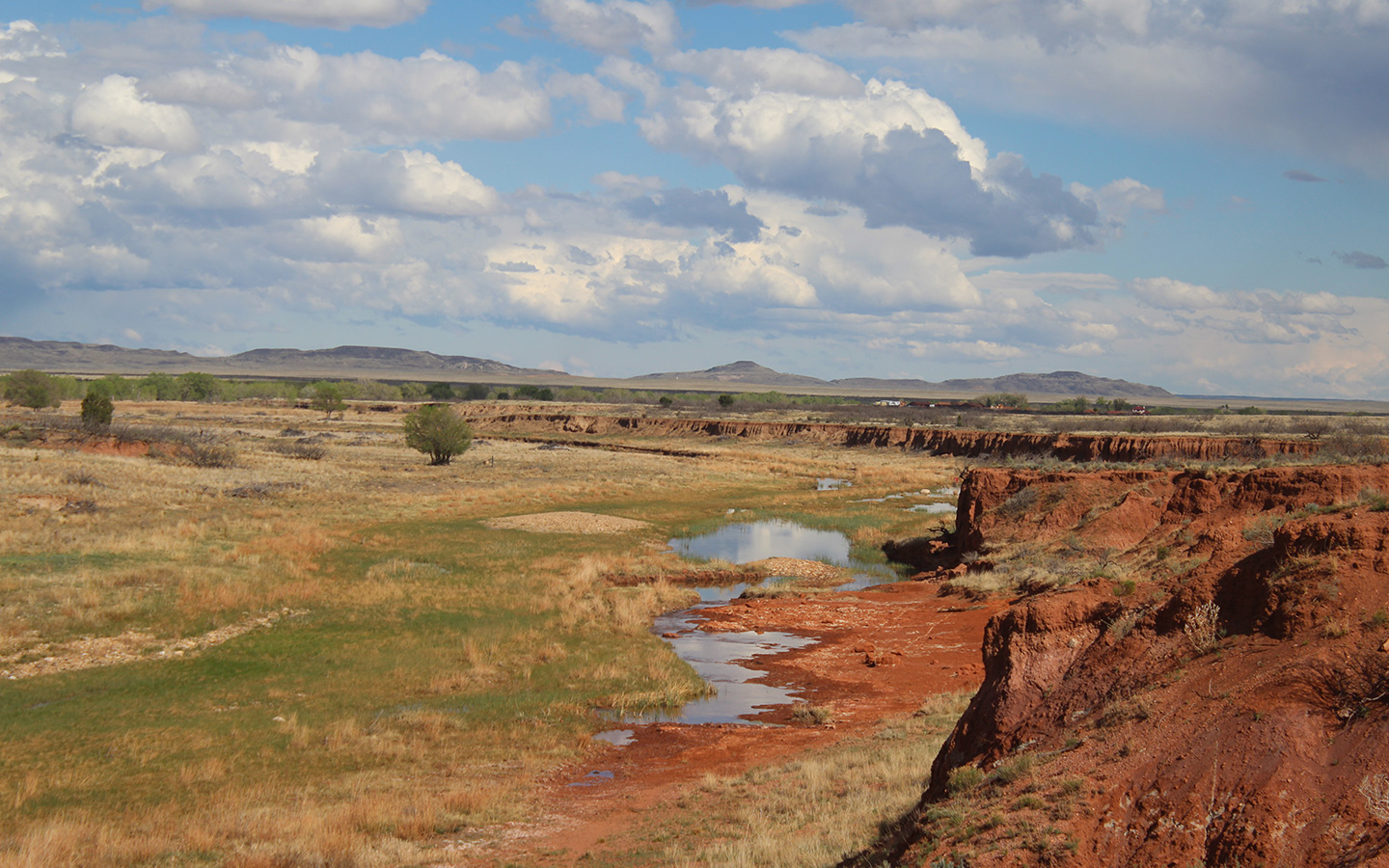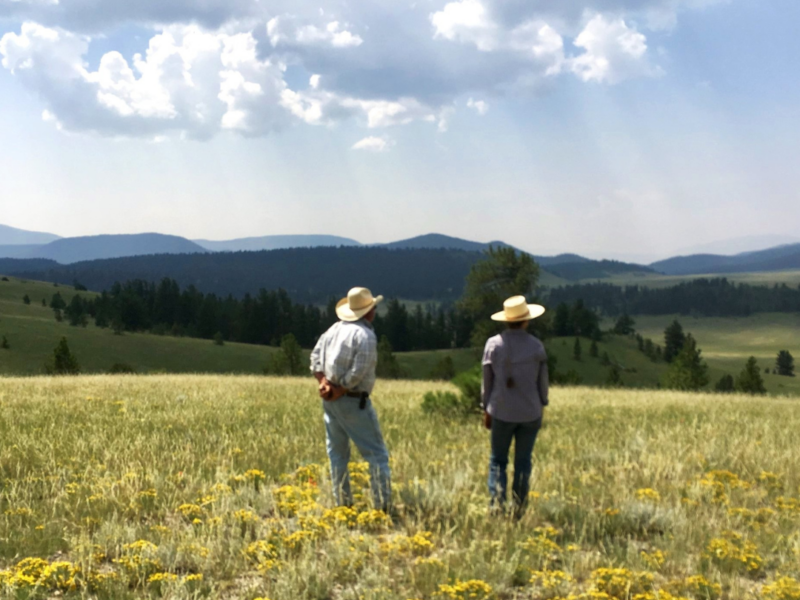Slaying salt cedar to save New Mexico’s Eastern Plains
Zooming along a two-lane highway just north of Tucumcari, New Mexico, few visitors are likely to notice the small grey piles lying along the banks of every single stream and dry wash. These humble, yet seemingly countless brush piles are actually the marks of an ongoing and immense struggle with one of the most destructive invaders in the American West: the salt cedar.
Introduced as early as the mid-1800s, the salt cedar (or tamarisk) is a non-native brushy plant from central Asia. In eastern New Mexico, men carried bundles of it on packsaddles into the short-grass prairie. At the time, no one realized how adept the plant would become at unraveling watersheds and riparian ecosystems.
“You have to understand, they were trying to stop erosion,” said Jack Chatfield, project manager for the Canadian River Riparian Watershed Restoration Project.
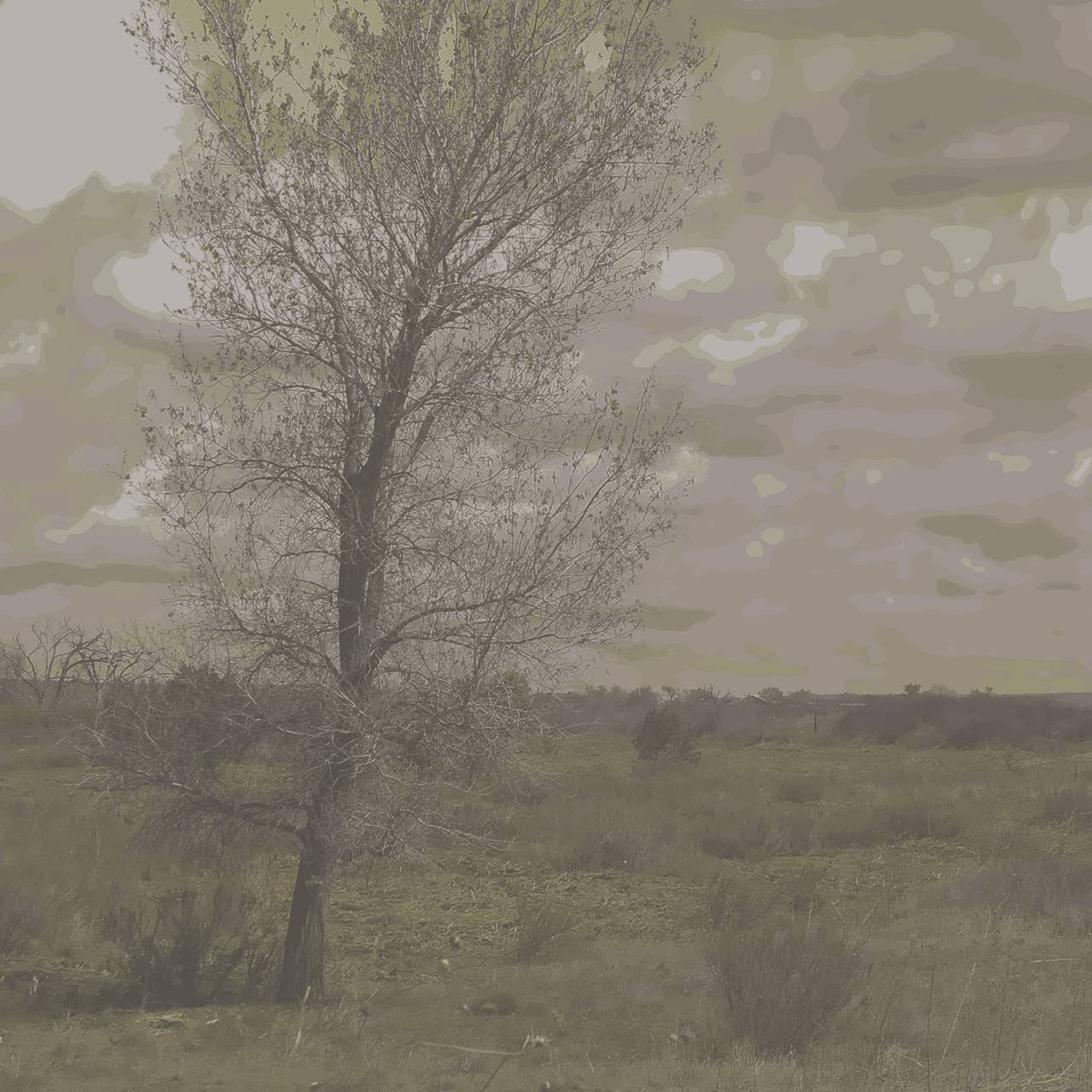
It’s late April and Chatfield is driving us across the vast grasslands in a bouncing little red jeep. Fortunately, there isn’t much traffic on the road because Chatfield is paying little attention to the dividing line on the asphalt as he points out one tributary after another to the Canadian River that has been treated to remove the salt cedar.
A lifetime New Mexico cowboy, rancher and camp cook, Chatfield has spent most of his life “out in the rocks,” as he put it. Today, however, when not fulfilling his duties as a newly elected state legislator, he spends his time visiting project sites, collaborating with partners, engaging local ranchers and coordinating work crews. He has also spent considerable time on his own nickel raising funding to keep the project going.
“The truth is, though, I love it,” he said.
Chatfield’s passion for the land, the cowboy way of life and for this particular restoration project is clear. He’s agreed to take two days out of his life and put hundreds of miles on his jeep to explain why this work is so important. To understand it requires an understanding of the plant itself.
People get out here after driving for a few hours and ask where the nearest gas station is. We have to tell them it’s another 75 miles and their eyes just bug out.
Jack Chatfield
Living canyon walls
Salt cedar is a stubborn, woody shrub with a root like a ten-foot long carrot. This long taproot draws salt out of the earth from deep underground, bringing it to the surface where it kills off other, less resourceful plants. With the disappearance of the native plants, the natural function of the entire ecosystem is disrupted. Salt cedar provides habitat for only a handful of wildlife species while eliminating the willows, cottonwoods and other plants native to the stream system that previously provided habitat for hundreds of species.
A more serious impact, however, is the change it creates in the hydrology of the system. The salt cedar grows thirty feet tall and into thickets so sturdy they form a living wall extending for miles on both sides of a stream, blocking the natural over-bank flows at high water. Without being able to spread, the water picks up speed in what has effectively become a narrow canyon, and with that increased velocity begins to carve a deeper channel into the earth. As the bed of the stream drops, it lowers the water table, drying out the prairie from below.
In addition, according to Chatfield, an average salt cedar uses up to 200 gallons of water per day, water that is no longer available to native plants, aquifer recharge, agriculture or wildlife.
The scope of the impact—and the restoration project—can be difficult to fathom. In the Canadian River watershed project alone, Chatfield has mapped more than 880,000 acres of riparian area and treated more than 33,000 salt cedar-infested acres. In this wide-horizon landscape, 33,000 acres is a speck on the map if depicted as a square. However, these acres fall out along the linear stream channels, stretching farther than a bouncing red jeep can show us over the course of two days of driving.
“People get out here after driving for a few hours and ask where the nearest gas station is,” said Chatfield, his blue eyes twinkling. “We have to tell them it’s another 75 miles and their eyes just bug out.”
In addition to the physical expanse of the landscape, the scope of the project is also immense in terms of the partnerships and coordination it entails. “We’re working with multiple counties and Conservation Districts, 21 agency and non-profit partners and more than 100 ranches,” Jack said. The project has been underway since 2003.
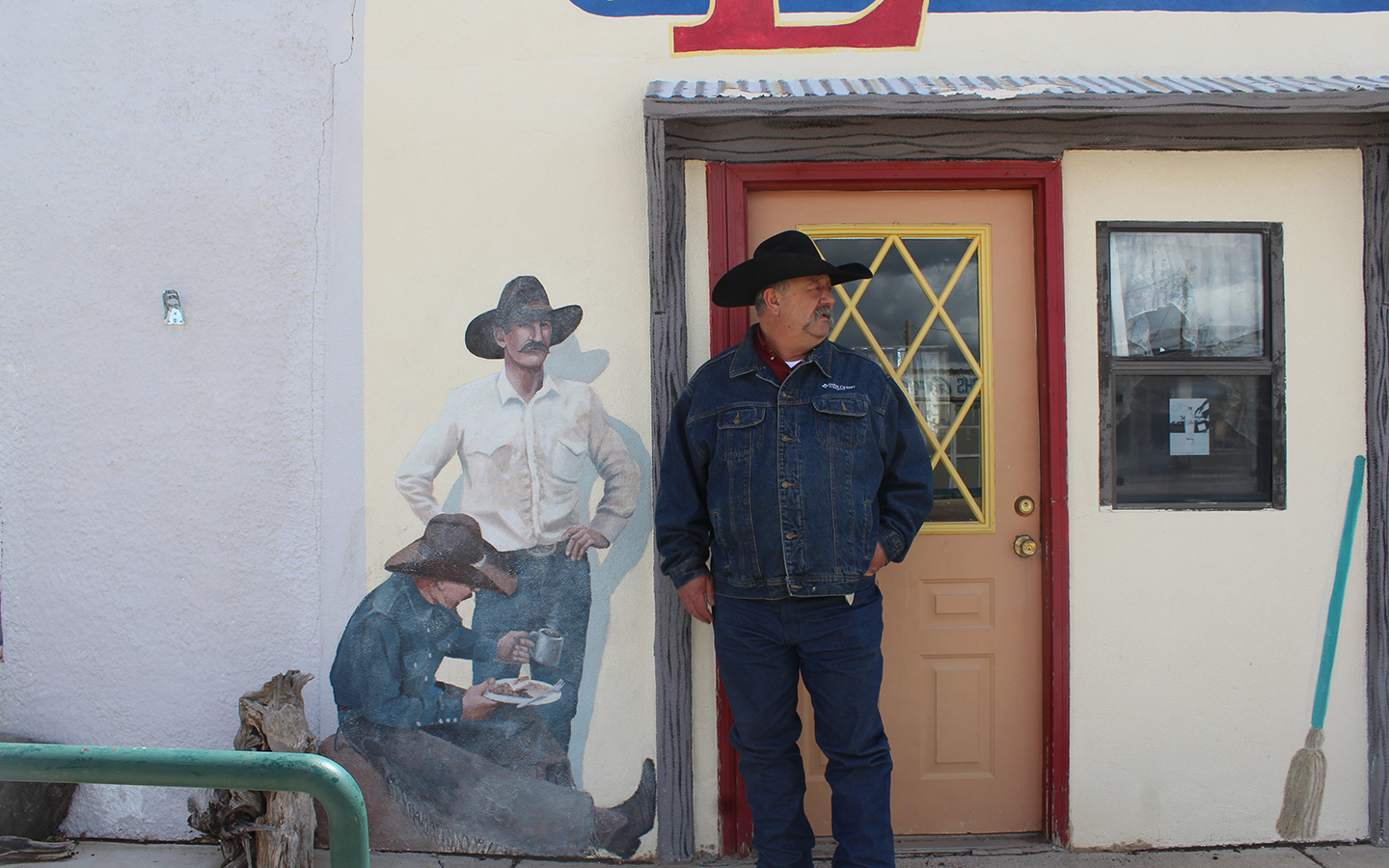
Off the wall
All around us stretch enormous ranches and from the highway few signs of human occupation are visible. Cattle have been grazing in this country since the mid-1800s. In fact, the Goodnight Loving Trail runs right through Mosquero where we stop for a short lunch. The trail is named after Charles Goodnight and Oliver Loving who in 1866 drove thousands of Texas longhorns from Ft. Sumner, New Mexico, to Denver, Colorado.
Without Chatfield as a guide, I might have blown past the little town of Mosquero, wondering vaguely as I passed about the murals painted on the sides of the little buildings. Even had I stopped on my own, I would never have guessed they were painted by the town’s high school students—they are just that good.
Before we sat to lunch at a picnic table sandwiched between the main street buildings, he gave us a tour of the murals that depict the town’s life, heritage and residents. These are not the amateur renditions one might expect of a school project. These are almost disturbingly life-like portraits that trick the eye repeatedly into believing for an instant that living people, bucking horses, dogs, fire engines and wildlife are emerging from the walls. One of the portraits depicts Chatfield himself in his other life as a cowboy camp cook.
As we would learn later that evening, there is much more to the Mosquero school, its students and their community than even these extraordinary murals convey.
Tequesquite restored
After lunch we hurried on to meet Tanner Mitchell of the sprawling Tequesquite Ranch that has been in his family for several generations. The Tequesquite has been a partner in the Canadian River Watershed Restoration Project, treating miles of salt cedar infestation on the ranch and successfully restoring long reaches of a wide, sandy, degraded wash back to a functioning riparian system.
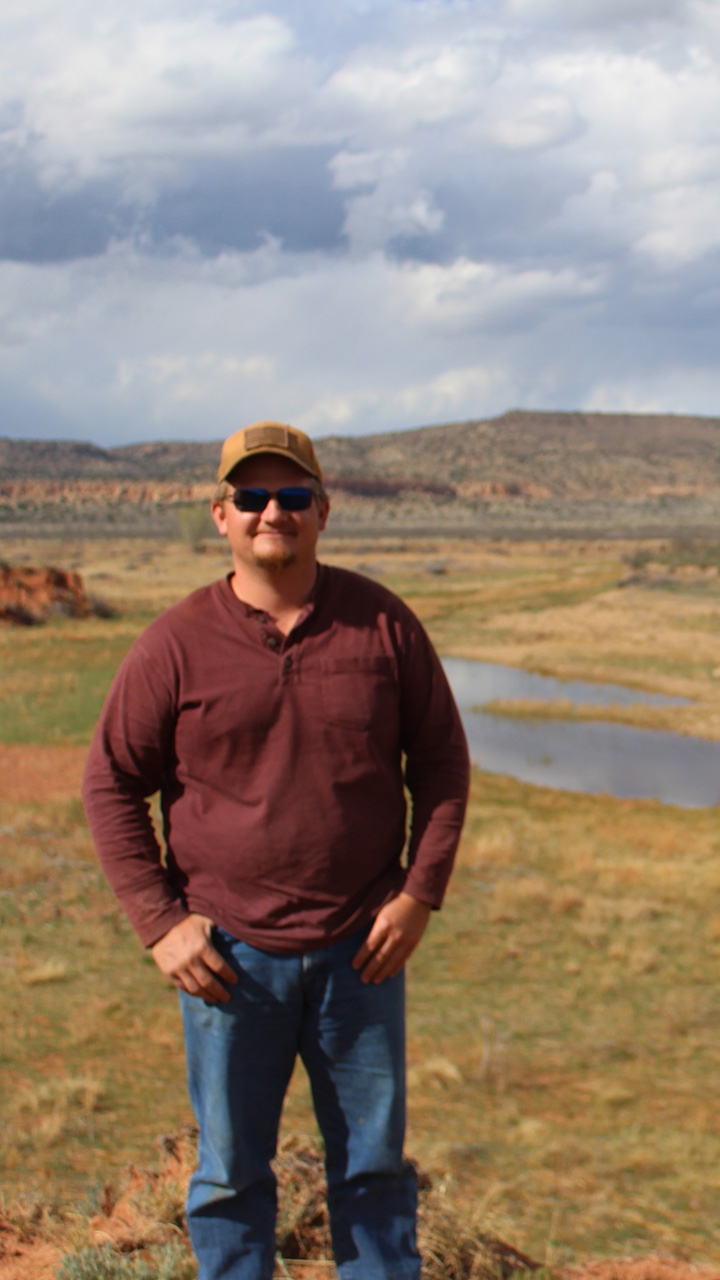
Mitchell explains to us that in addition to the salt cedar removal, the ranch has changed its grazing management to increase rest during growing seasons and installed in-stream structures designed by stream expert Bill Zeedyk to slow water and restore natural meandering. The positive results of these efforts are immediately evident as we compare the treated and untreated sections of stream. What may be most remarkable is that much of this progress has happened during one of the most severe droughts in the region’s history.
The ranch is also managing juniper for both livestock and wildlife, reintroducing fire, employing high intensity rotational grazing, reducing erosion and conserving wetland areas. We paused at one point along a ranch road to photograph ducks. In fact, the ranch reintroduced beavers but a 100-year flood event recently wiped out all but one. They are currently awaiting the arrival of more beavers to provide company to the solitary survivor and restart the population.
The Tequesquite Ranch is also monitoring groundwater depletions and recharge to help guide the ranch’s water resource management. In addition, Mitchell is replacing old-fashioned windmills with solar-powered pumps for the stock tanks that utilize a float switch to conserve water. The ranch is funding these efforts out-of-pocket based on a strong land ethic and the conviction that diverse, healthy lands are the foundation for economic success.
Ute Creek Creativity
The sun was getting low as we departed the Tequesquite Ranch for Ute Creek Cattle Company. Tuda and Jack Crews greeted us with hugs and iced tea at the front door. We sat in the living room of their beautifully decorated adobe home for a while and learned about the history and management of this multi-generational ranch. As a seventh-generation ranch owner, Tuda had grown up on her family’s large ranch. But she married young and moved to Wyoming for much of her adult life. Nineteen years ago, after inheriting one-fifth of her family’s ranch, she and her husband Jack returned to operate her portion of the ranch. Tuda’s siblings own and operate surrounding sections.
Ute Creek Cattle Company is managed holistically to maximize forage production utilizing an adaptive grazing system that provides over 100 days of rest during the growing season to 75% of the pastures. This has impacts for everything from herd health, to meat quality to biodiversity.
Over the last one and a half decades, for example, the bird count has increased from 17 species to over one hundred. And what is good for the birds is good for other wildlife; animal life on the ranch now includes elk, badger, raccoon and fox as well as whitetail and mule deer, pronghorn, mountain lion, bobcat, prairie dog and many others.
“One of our ranch principles is to host at least one educational event per year,” Tuda said. At one particular school-age event, the children were provided with their own sets of binoculars so they could continue bird watching after experiencing it on the ranch.
In August of 2018, the ranch partnered with Audubon New Mexico to host a workshop focusing on wild bird habitat development and using birds as a yardstick to measure land health.
Tuda tracks monarch butterflies and plants milkweed around the ranch. A 23-acre wild bird sanctuary provides habitat, food, water, shade, breeding and nesting areas for short-grass prairie birds.
It’s said severe drought impacts the minds of people who live through it, and the drought of 2008 to 2012 was among the worst in recorded history for the region. Tuda and Jack agree. “It changes you, Tuda said. In this arid country, a constant reminder of drought weighs heavy on our minds.”
At Ute Creek Cattle Company, the number one ranch priority is soil health. Using cattle as a tool, the adaptive grazing system provides animal impact, fertilizer and rest periods necessary for plant roots to thrive. With more roots and creatures living in the soil, soil porosity goes up: when it rains, the soil acts just like a sponge, soaking up precious extra drops.
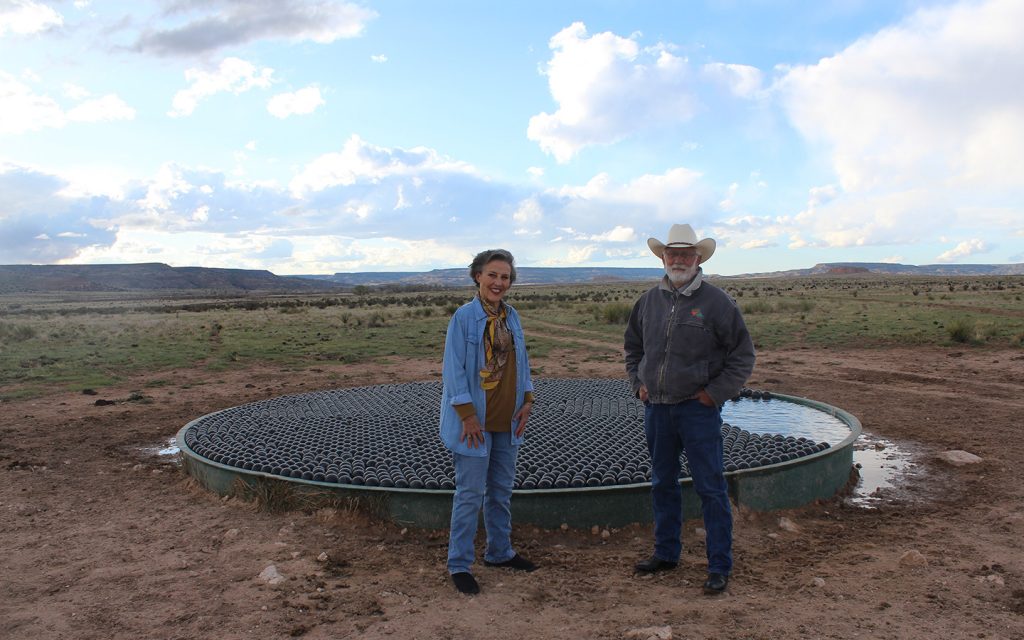
Focused on conserving water at every opportunity, the Crews developed an innovative water distribution system that incorporates water-saving measures. Twenty miles of pipeline gravity-flows stock water to 26 pastures. Five drinkers rest on the fence-line, doubling water distribution. Float boxes on each tank stabilize water levels to conserve water and provide adequate recharge when cattle come to water. A few windmills still dot the landscape and support overflow ponds where birds and wildlife thrive.
Tuda applied for and received a Small Business Development Assistance grant. The grant provides access to expertise from the Sandia National Laboratory lab to pursue innovative ideas. In this case, Crews wanted to limit evaporative losses of water from stock tanks.
Assisted by the lab, “Shade Balls” were found. These little black spheres are partially filled with water and float on the top of the tank. By covering the surface of a 20 ft. tank with shade balls, evaporative loss drops 90%: every 20’ tank covered with the balls saves 16,000 gallons of underground water each year. The cattle have adjusted well, and the balls have the additional benefit of limiting the growth of moss and also reducing freezing in and around the tanks. Never one to sit still, Tuda acquired another technology grant to further address the problem of water freezing in stock tanks.
In addition, the house grounds are xeriscaped and water catchment systems collect rainwater from roofs. Water is too precious to waste a drop out here.
Of the many things they have done to improve the ranch, Tuda said the greatest was eliminating salt cedar and restoring year-round water on 10 miles of Ute Creek. Ute Creek is a regional model of successful riparian habitat restoration and has enhanced aquatic life and water quality.
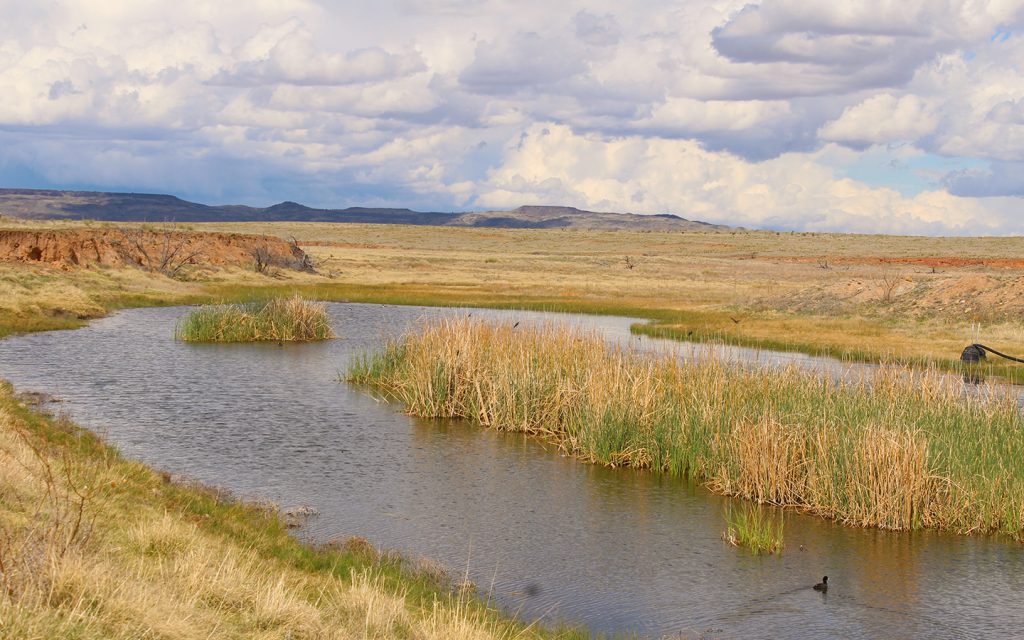
“We’ve done a lifetime of work in 19 years,” she said. “Ranching takes time and resources. We could never have accomplished what we have without collaboration and partnerships with NRCS, Ute Creek Soil & Water Conservation District, NM Water Trust Board and many others. We’ve put everything back into the ranch”.
Partnerships and collaboration allowed implementation of progressive conservation practices. Many agencies and organizations played a role, including USDA-NRCS, New Mexico Water Trust Board, C3RP, National Wild Turkey Federation, New Mexico Game & Fish Department, USFWS Partners for Fish and Wildlife program and numerous others. In 2019, Ute Creek Cattle Company received the prestigious National Cattleman’s BEEF Association’s Environmental Stewardship Award for Region VI.
A place worth staying
The sun was setting when we headed out for a field visit around the Ute Creek Cattle Company Ranch to check out Shade Balls in a tank, the new crop of sturdy black calves, the restored stream channel in which willows and other native vegetation have replaced the salt cedar thickets, and the large turquoise corrals designed by Temple Grandin to reduce stress when handling livestock.
We hope that by taking care of the land, providing a good education and creating a close-knit community with jobs and opportunities to start their own businesses at home in Harding County, we can provide a future for them here.
Tuda Libby Crews
Riding together into town for a hosted dinner after the tour, Tuda explained how the community is working to support local youth in their education. Among other things, they have acquired major grants for the local school, including a technology grant from Microsoft’s “Partners in Learning” program that provided the latest technology equipment for student use. A state-of-the-art media center was constructed where students publish a newspaper and use the center to create their own businesses. Mosquero Schools have been recognized nationally for its entrepreneurship program.
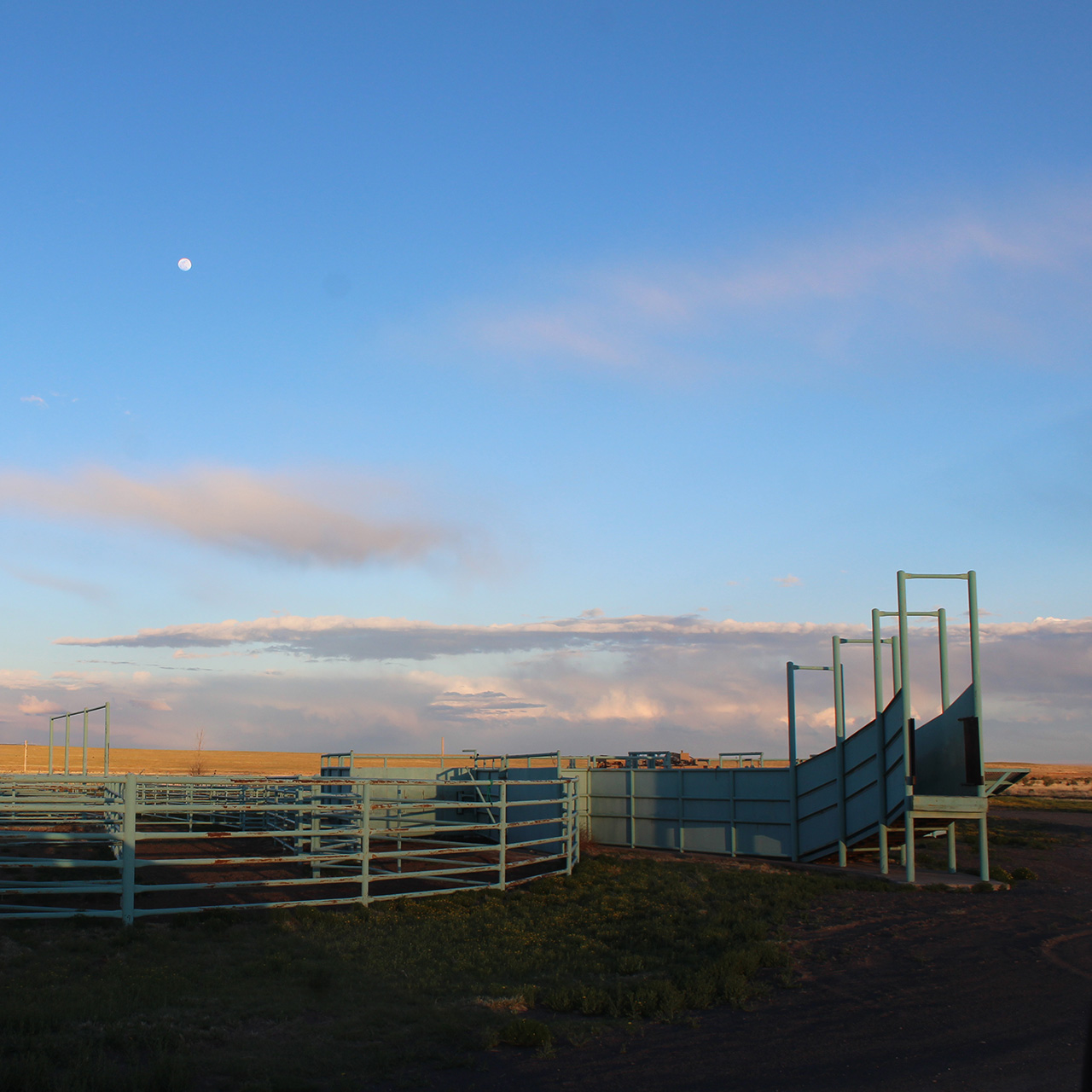
In 2019, the addition of online classes has increased enrollment to almost eighty students. Harding County is a Nationally Accredited MainStreet Community which includes a nineteen-mile-long Cultural District. The program includes Roy and Mosquero Schools and encourages county-wide community collaboration and partnerships.
The Mosquero Schools are one of the few public schools in the country with their own indoor/outdoor Equestrian Center. In this rural landscape, the Equestrian Center hosts ranching/rodeo events and doubles as a social spot where community members gather for roping events.
As with other rural communities, Mosquero is deeply concerned about succession and the fate of future generations.
“We want our young people to go out and get an education and explore the world, and we encourage them to return home afterwards and start their own business and raise their families here,” Tuda explained.
To underscore this, the community has developed a ritual for each year’s graduating class. In a scripted ceremony, each student is presented with a decorated mailbox as a way to say, “You will always have a home here when you are ready to return.”
“We hope that by taking care of the land, providing a good education and creating a close-knit community with jobs and opportunities to start their own businesses at home in Harding County, we can provide a future for them here,” Tuda said.
Chemical challenge
The restoration of the Canadian River watershed has not been without controversy. Some environmental organizations have expressed concern about the aerial application of herbicide to kill the salt cedar. As Jack explained, the primary chemical being used for the project is Imazapyr. It works by blocking an enzyme in the plant that produces leaves. Without leaves, the plant cannot photosynthesize and dies. It has a low toxicity rating for birds, mammals, fish and macroinvertebrates, though it does not bind easily to soil and can therefore migrate to other plants. It has a half-life of one to five months in soil and as little as two days in aqueous environments. “We’ve tested the impacts on macroinvertebrates and found no effects—zero,” Jack said.
As in most land management challenges, there are few simple or clear solutions. Is the environmental impact of applying an herbicide worse than the ongoing impacts of a non-native, salt-cedar invasion? If so, what are the alternatives and can we afford them? Do biological controls work and what are the risks associated with those? Can we afford not to address the problem? These are things that will be discussed, debated and studied into the foreseeable future.
In the meantime, as we stand in Mills Canyon, the flourishing willows, cottonwoods and grasses that have returned following the salt-cedar removal make a compelling case that the land is healing. Walking back to the red jeep, we note turkey, deer and elk tracks in the sandy canyon bottom and pause to smell the blossoms of a plum tree from a long-abandoned orchard. As we drive back up the rough little dirt road, we pass a young couple knee deep in the river with fishing poles. Further on, a flock of turkeys crosses a small expanse of grass to disappear into a thicket of willows.
“We’ve changed the landscape,” Chatfield said. “We’ve made a difference and the effects will be long lasting, but you can’t just do it and walk away. There are miles and miles of areas that are better than they used to be and hopefully people will step in there and keep them productive. It’s beneficial to the watershed and it also benefits those of us who live in this watershed because it increases quality of production and the quality of life for all of us.”


